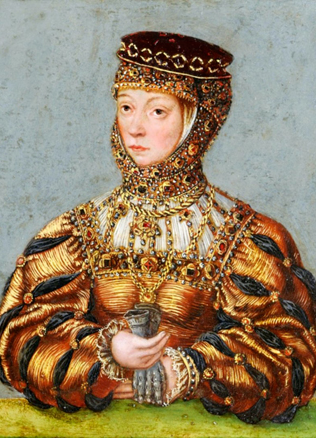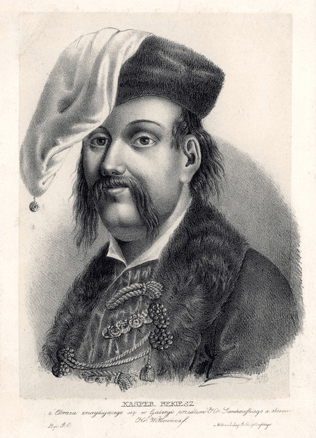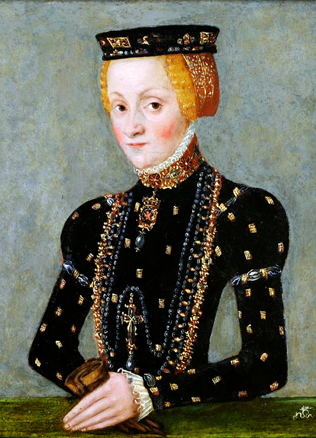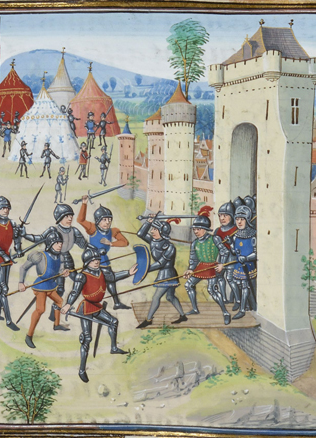The early monarchy – the unconsolidated Grand Duchy of Lithuania
The medieval monarchy resembles but little the territorial and institutional state of modern times. For a long time no conception of the defined territory of the country that was marked by the borders existed. The country was ruled by the relatives and noble subordinates loyal to the Ruler rather than by the officials with more or less clear competences appointed by the Ruler. The early monarchy was a political formation, which functioned as a system of personal ties of the representatives of the ruling elite. The existence of such a formation required that the persons belonging to the ruling strata should be linked by an immediate relation of subordination, loyalty and friendship, and each death of the ruler who bound that system posed a threat to the stability of the created political system. Right until the 15th century there was not a single non-conflicting case of inheritance of the throne. During the period of the creation of the state in the 13th – the 14th centuries, the “political” institutions were especially unstable, the offices that were created disappeared within some time, they were replaced with the new ones, the formations that were not encompassed by the system of governance existed alongside the created territorial structures of the state.
The discontinuity of a political and social development characteristic of the early monarchies is reflected by the cracks in statehood tradition. In the 14th century, the rulers from the Gediminds dynasty knew little about their “predecessor” King Mindaugas. This fact testifies to the dramatic changes that took place at the time of the formation of the state. Several political crises that followed one another after Mindaugas’ murder and the events that took place during the last decades of the 13th century, when internal quarrels and external pressures posed a real danger to the continuity of the newly formed political formation, are characteristic phenomena of the early monarchy. Nonetheless, the renewal of the state tradition shows the maturity of the ruling elite of that time and the attempts of the dominant groups to look for new integration ideas to preserve the continuity of the political community. The most important factor here was the appearance of the political elite, which was made up of the rising ruling family (stirps regia) and the groups of the nobility that were closely related to it. The families who constituted that elite came from the defined region (Lithuania propria), and they were united by the neighbourhood of the estates, marital kinship and the relations of loyalty and friendship being formed.
Challenges of governing the wastelands
The possibilities that appeared for a rapid enlargement of the state towards the east in the times of the Gediminids were a new challenge to the political community. The annexation of the new territories made the ruling strata look for political solutions, which could assure existence of a territorially poorly integrated state. Therefore the Ruthenian lands, which accepted the dukes of the Gediminds origin preserved their old social structures (“antiquity” – старина) – the local nobility were left their traditional rights and land ownership.
“
The annexation of the new territories made the ruling strata look for political solutions, which could assure existence of a territorially poorly integrated state.
Politically, however, the nobility that was in the “centre” of the state dominated all the time. The links between the traditional nucleus and a growing periphery survived until the new wave of integration, which started in the Grand Duchy of Lithuania in the 15th and the 16th centuries.
Even under the medieval conditions the Grand Duchy of Lithuania was a scarcely populated country of bad communications. For example, in 1413, the knight of Burgundy Ghillebert de Lannoy who travelled from Livonia to meet Vytautas did not see any settlement for two days and nights of his journey until he reached Vytautas’ estate fifteen miles away (one mile is approximately 7 kilometres). In such conditions specially appointed service men (guides) helped to orient oneself in the location, and security was guaranteed by the document marked by the sign of the Ruler – glejt (in polish).
If in the west the borders of the country were more or less clear, it is more difficult to speak about the borders in the east. The lands of Polock, Vitebsk, Smolensk, Chernigov and Kiev had no natural borders and were difficult to be defended or even perceived. Steppes stretched in the south-east where most probably no conception of the borders existed at all.
“
Steppes stretched in the south-east where most probably no conception of the borders existed at all.
A quarrel with Poland and Hungary about the land of Galicia-Volhynia and Podolia went on in the south-west. Meanwhile a conflict over Podlachia arose with the dukes of Masovia. The governance of the huge (at the turn of the 14th and the 15th centuries theoretically the Grand Duchy of Lithuania covered approximately one million square kilometres) but scarcely populated country (about 3-4 people per square kilometre) was based on the mechanisms, which did not resemble the functioning of a territorial state at all.
The structure of the state: a network of the centres of the Duke’s power
The eastern part of ethnic Lithuania and some lands of Black Russia (the territories of current East Lithuania and West Belarus), the so-called “proper Lithuania” (Lithuania propria) constituted the nucleus of the state from the times of Mindaugas. Main holdings of the Gediminids dynasty were there, with the most important residential castles and patrimonies of the nobility stretching there. A well-developed system of estates and castles of the Grand Duke existed in the territory – the political and economic centre of the country’s governance. The rulers’ itineraries (routes of the journeys of Jogaila, Vytautas, Švitrigaila, Žygimantas Kęstutaitis worked out on the basis of the documents) testify to the fact that the Grand Dukes spent the largest part of their time in that region, and they travelled to a more distant lands only sometimes. There they had to rely on the loyalty of local or vassal dukes of the Gediminids dynasty.
“
The conception of the “capital city” (the royal city/civitas regia) of the Grand Duke appeared in the sources for the first time during the rule of Gediminas.
The structure of the state remained heterogeneous for a long time. The Grand Duke ruled through the government centres distributed in the strategic places of the country where he had established castles and estates with the elder’s administration. The inherited holdings of the nobility stretched next to the Ruler’s domain. The conception of the “capital city” (the royal city/civitas regia) of the Grand Duke appeared in the sources for the first time during the rule of Gediminas. From that time governance of Vilnius was inseparable from the Grand Duke’s power though we can speak about the “capital” only conditionally. The administration of the estates governed only peasant communities and the Grand Duke’s power with respect to the nobility was based on the personal relations rather than on territorial and administrative subordination.
The formation of the Grand Duchy of Lithuania was a real geopolitical leap: within a short time, in the middle of the 13th century, a small country grew into the largest state of the region from the territorial point of view. That was not a continuous and integrated political formation; however, it had a flexible and vital political organisation, which the rulers and the nobility knew how to make use of in solving different political problems. This land that balanced between the East and the West, between orthodoxy and Catholicism and accepting various confessions (at that time already the Jewish, Tartar and Karaite communities lived there) did not only take over foreign influences but also spread its own one gradually. The time of consolidation and the creation of new institutions came at the beginning of the 15th century under the rule of Grand Duke Vytautas.
Rimvydas Petrauskas



